Ethical Change Management: Analysis of Lakeland Wonders Case Study
VerifiedAdded on 2023/06/03
|5
|1423
|212
Case Study
AI Summary
This case study examines the ethical dimensions of change management within the context of the Lakeland Wonders scenario. It analyzes Mark Dawson's resistance to Cheryl's proposed expansion move, particularly the shift to offshore manufacturing, highlighting his concerns about potential negative impacts on U.S. operations, contract negotiations, and union relations. The study critiques Cheryl's autocratic leadership style and her failure to adequately consider the ethical implications of her change management approach, including the lack of employee involvement and insufficient evidence to support her plans. Recommendations include fostering senior management support through transparent communication, understanding and addressing cultural differences in offshore manufacturing, and prioritizing employee input to mitigate resistance. The paper emphasizes the importance of ethical considerations and inclusive leadership in successful change management initiatives. Desklib offers this student-contributed solution along with a wealth of study resources to support students.
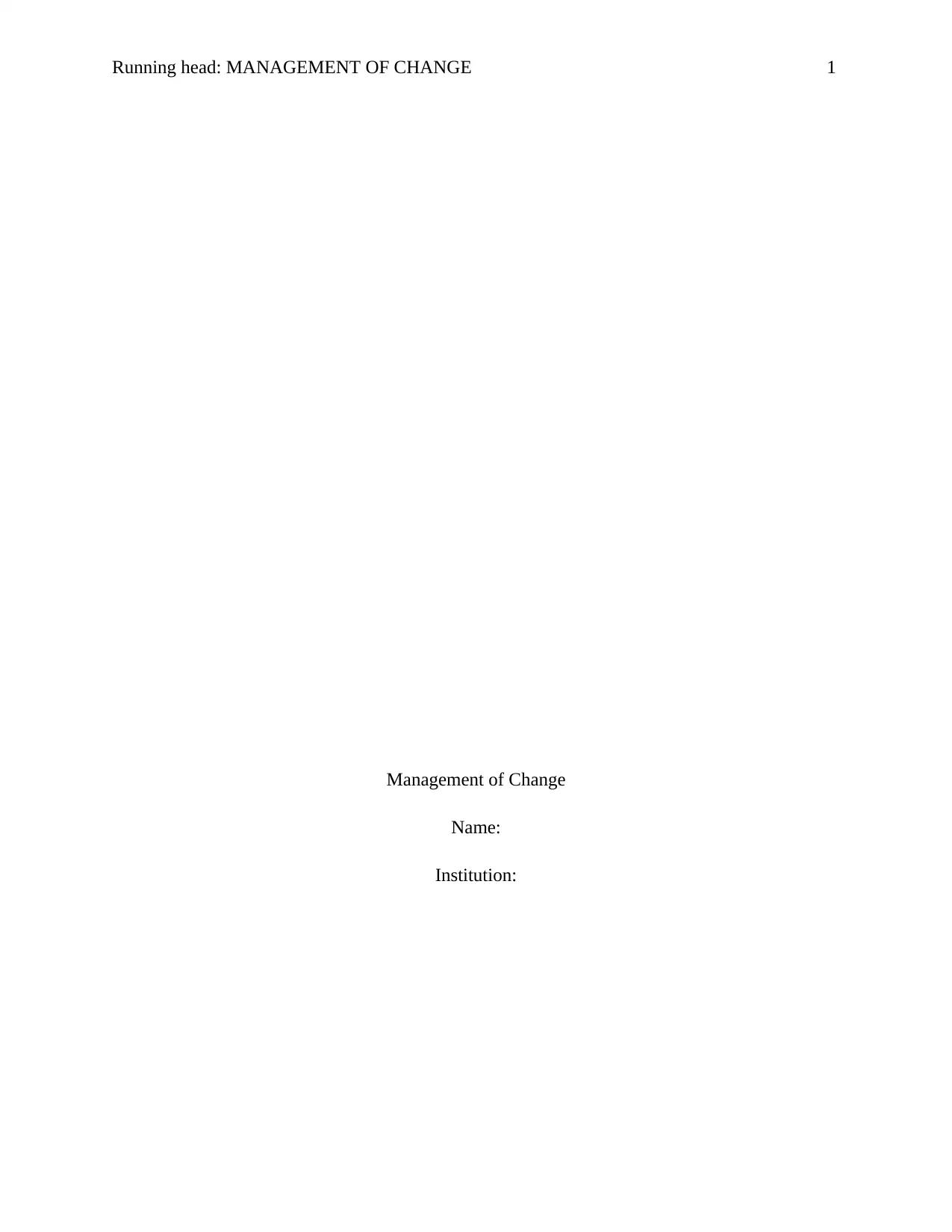
Running head: MANAGEMENT OF CHANGE 1
Management of Change
Name:
Institution:
Management of Change
Name:
Institution:
Paraphrase This Document
Need a fresh take? Get an instant paraphrase of this document with our AI Paraphraser
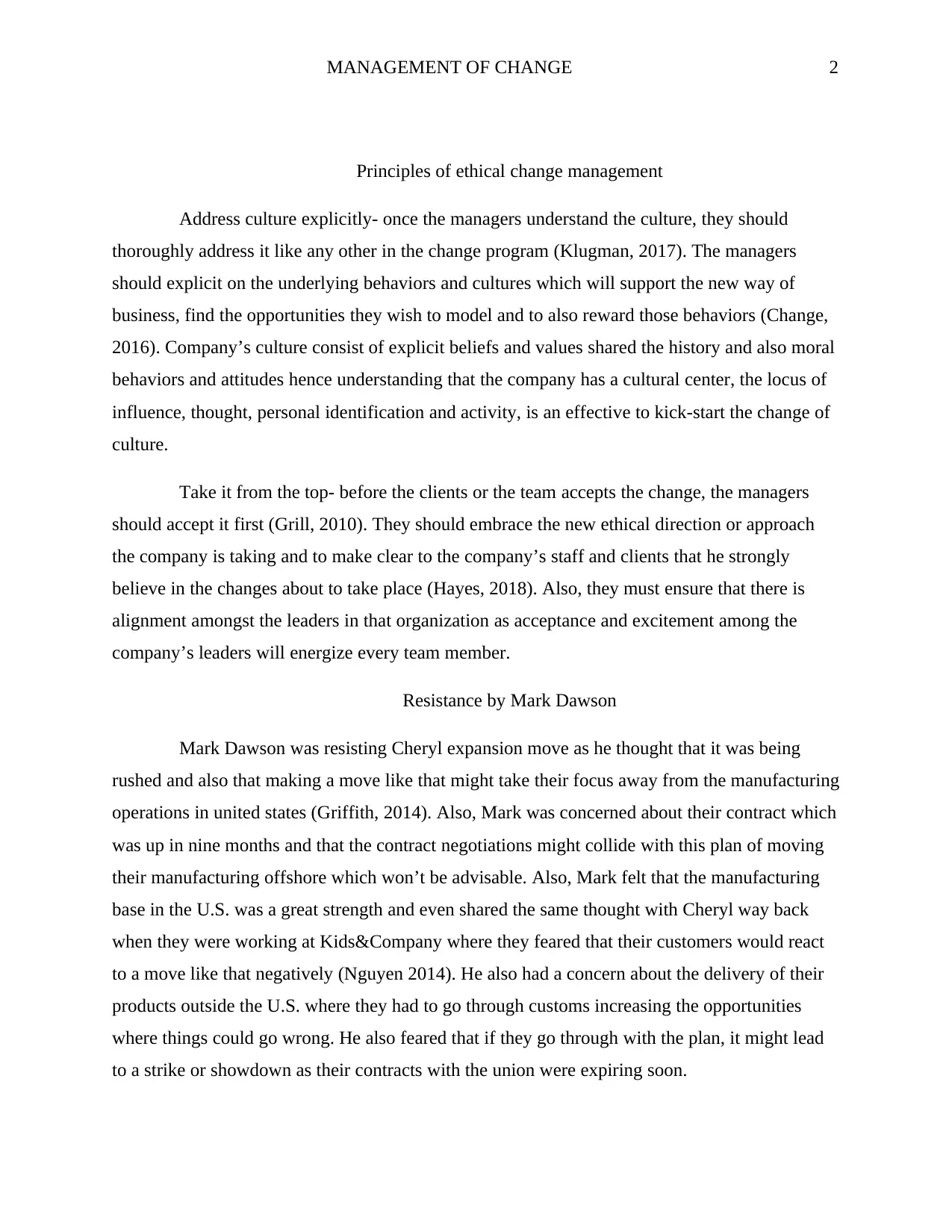
MANAGEMENT OF CHANGE 2
Principles of ethical change management
Address culture explicitly- once the managers understand the culture, they should
thoroughly address it like any other in the change program (Klugman, 2017). The managers
should explicit on the underlying behaviors and cultures which will support the new way of
business, find the opportunities they wish to model and to also reward those behaviors (Change,
2016). Company’s culture consist of explicit beliefs and values shared the history and also moral
behaviors and attitudes hence understanding that the company has a cultural center, the locus of
influence, thought, personal identification and activity, is an effective to kick-start the change of
culture.
Take it from the top- before the clients or the team accepts the change, the managers
should accept it first (Grill, 2010). They should embrace the new ethical direction or approach
the company is taking and to make clear to the company’s staff and clients that he strongly
believe in the changes about to take place (Hayes, 2018). Also, they must ensure that there is
alignment amongst the leaders in that organization as acceptance and excitement among the
company’s leaders will energize every team member.
Resistance by Mark Dawson
Mark Dawson was resisting Cheryl expansion move as he thought that it was being
rushed and also that making a move like that might take their focus away from the manufacturing
operations in united states (Griffith, 2014). Also, Mark was concerned about their contract which
was up in nine months and that the contract negotiations might collide with this plan of moving
their manufacturing offshore which won’t be advisable. Also, Mark felt that the manufacturing
base in the U.S. was a great strength and even shared the same thought with Cheryl way back
when they were working at Kids&Company where they feared that their customers would react
to a move like that negatively (Nguyen 2014). He also had a concern about the delivery of their
products outside the U.S. where they had to go through customs increasing the opportunities
where things could go wrong. He also feared that if they go through with the plan, it might lead
to a strike or showdown as their contracts with the union were expiring soon.
Principles of ethical change management
Address culture explicitly- once the managers understand the culture, they should
thoroughly address it like any other in the change program (Klugman, 2017). The managers
should explicit on the underlying behaviors and cultures which will support the new way of
business, find the opportunities they wish to model and to also reward those behaviors (Change,
2016). Company’s culture consist of explicit beliefs and values shared the history and also moral
behaviors and attitudes hence understanding that the company has a cultural center, the locus of
influence, thought, personal identification and activity, is an effective to kick-start the change of
culture.
Take it from the top- before the clients or the team accepts the change, the managers
should accept it first (Grill, 2010). They should embrace the new ethical direction or approach
the company is taking and to make clear to the company’s staff and clients that he strongly
believe in the changes about to take place (Hayes, 2018). Also, they must ensure that there is
alignment amongst the leaders in that organization as acceptance and excitement among the
company’s leaders will energize every team member.
Resistance by Mark Dawson
Mark Dawson was resisting Cheryl expansion move as he thought that it was being
rushed and also that making a move like that might take their focus away from the manufacturing
operations in united states (Griffith, 2014). Also, Mark was concerned about their contract which
was up in nine months and that the contract negotiations might collide with this plan of moving
their manufacturing offshore which won’t be advisable. Also, Mark felt that the manufacturing
base in the U.S. was a great strength and even shared the same thought with Cheryl way back
when they were working at Kids&Company where they feared that their customers would react
to a move like that negatively (Nguyen 2014). He also had a concern about the delivery of their
products outside the U.S. where they had to go through customs increasing the opportunities
where things could go wrong. He also feared that if they go through with the plan, it might lead
to a strike or showdown as their contracts with the union were expiring soon.
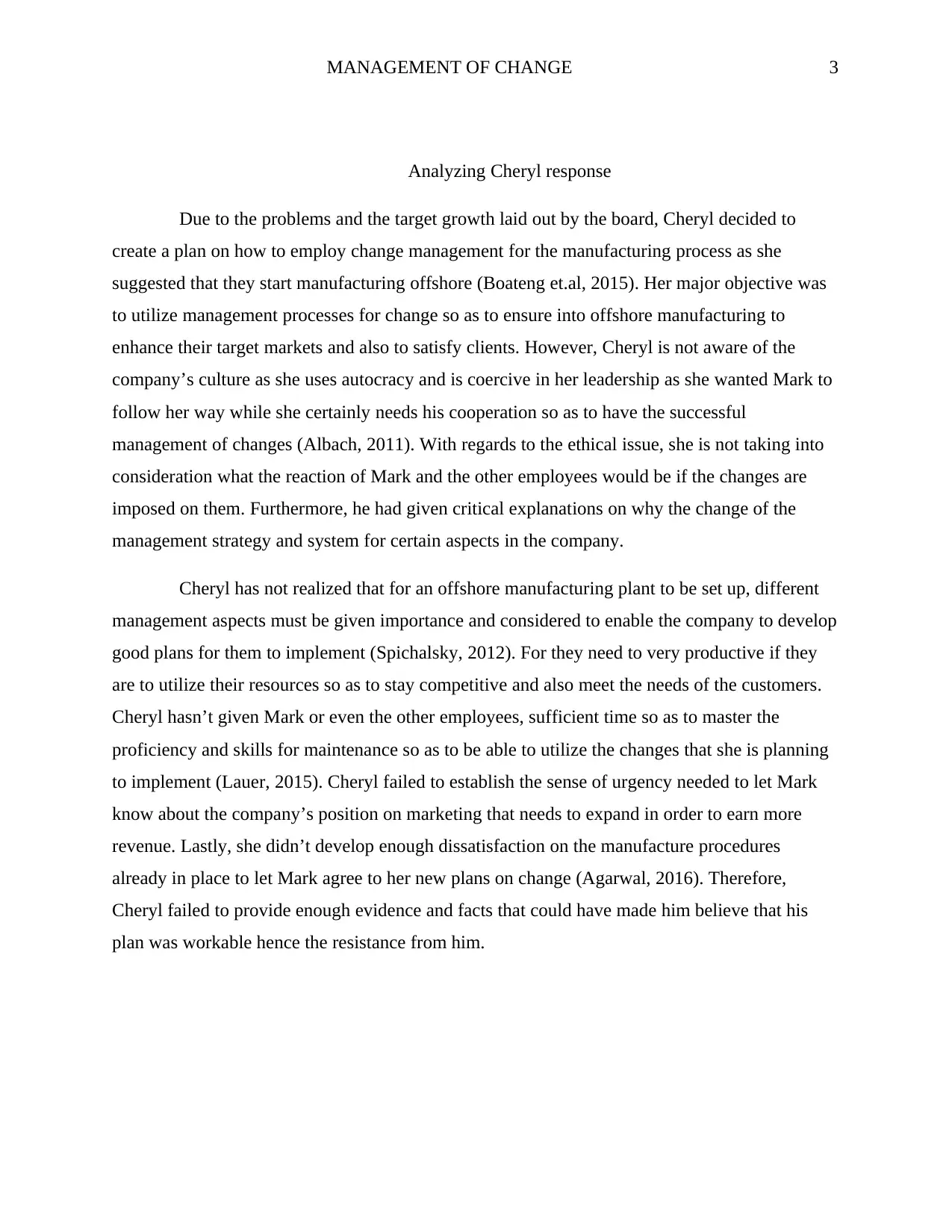
MANAGEMENT OF CHANGE 3
Analyzing Cheryl response
Due to the problems and the target growth laid out by the board, Cheryl decided to
create a plan on how to employ change management for the manufacturing process as she
suggested that they start manufacturing offshore (Boateng et.al, 2015). Her major objective was
to utilize management processes for change so as to ensure into offshore manufacturing to
enhance their target markets and also to satisfy clients. However, Cheryl is not aware of the
company’s culture as she uses autocracy and is coercive in her leadership as she wanted Mark to
follow her way while she certainly needs his cooperation so as to have the successful
management of changes (Albach, 2011). With regards to the ethical issue, she is not taking into
consideration what the reaction of Mark and the other employees would be if the changes are
imposed on them. Furthermore, he had given critical explanations on why the change of the
management strategy and system for certain aspects in the company.
Cheryl has not realized that for an offshore manufacturing plant to be set up, different
management aspects must be given importance and considered to enable the company to develop
good plans for them to implement (Spichalsky, 2012). For they need to very productive if they
are to utilize their resources so as to stay competitive and also meet the needs of the customers.
Cheryl hasn’t given Mark or even the other employees, sufficient time so as to master the
proficiency and skills for maintenance so as to be able to utilize the changes that she is planning
to implement (Lauer, 2015). Cheryl failed to establish the sense of urgency needed to let Mark
know about the company’s position on marketing that needs to expand in order to earn more
revenue. Lastly, she didn’t develop enough dissatisfaction on the manufacture procedures
already in place to let Mark agree to her new plans on change (Agarwal, 2016). Therefore,
Cheryl failed to provide enough evidence and facts that could have made him believe that his
plan was workable hence the resistance from him.
Analyzing Cheryl response
Due to the problems and the target growth laid out by the board, Cheryl decided to
create a plan on how to employ change management for the manufacturing process as she
suggested that they start manufacturing offshore (Boateng et.al, 2015). Her major objective was
to utilize management processes for change so as to ensure into offshore manufacturing to
enhance their target markets and also to satisfy clients. However, Cheryl is not aware of the
company’s culture as she uses autocracy and is coercive in her leadership as she wanted Mark to
follow her way while she certainly needs his cooperation so as to have the successful
management of changes (Albach, 2011). With regards to the ethical issue, she is not taking into
consideration what the reaction of Mark and the other employees would be if the changes are
imposed on them. Furthermore, he had given critical explanations on why the change of the
management strategy and system for certain aspects in the company.
Cheryl has not realized that for an offshore manufacturing plant to be set up, different
management aspects must be given importance and considered to enable the company to develop
good plans for them to implement (Spichalsky, 2012). For they need to very productive if they
are to utilize their resources so as to stay competitive and also meet the needs of the customers.
Cheryl hasn’t given Mark or even the other employees, sufficient time so as to master the
proficiency and skills for maintenance so as to be able to utilize the changes that she is planning
to implement (Lauer, 2015). Cheryl failed to establish the sense of urgency needed to let Mark
know about the company’s position on marketing that needs to expand in order to earn more
revenue. Lastly, she didn’t develop enough dissatisfaction on the manufacture procedures
already in place to let Mark agree to her new plans on change (Agarwal, 2016). Therefore,
Cheryl failed to provide enough evidence and facts that could have made him believe that his
plan was workable hence the resistance from him.
⊘ This is a preview!⊘
Do you want full access?
Subscribe today to unlock all pages.

Trusted by 1+ million students worldwide
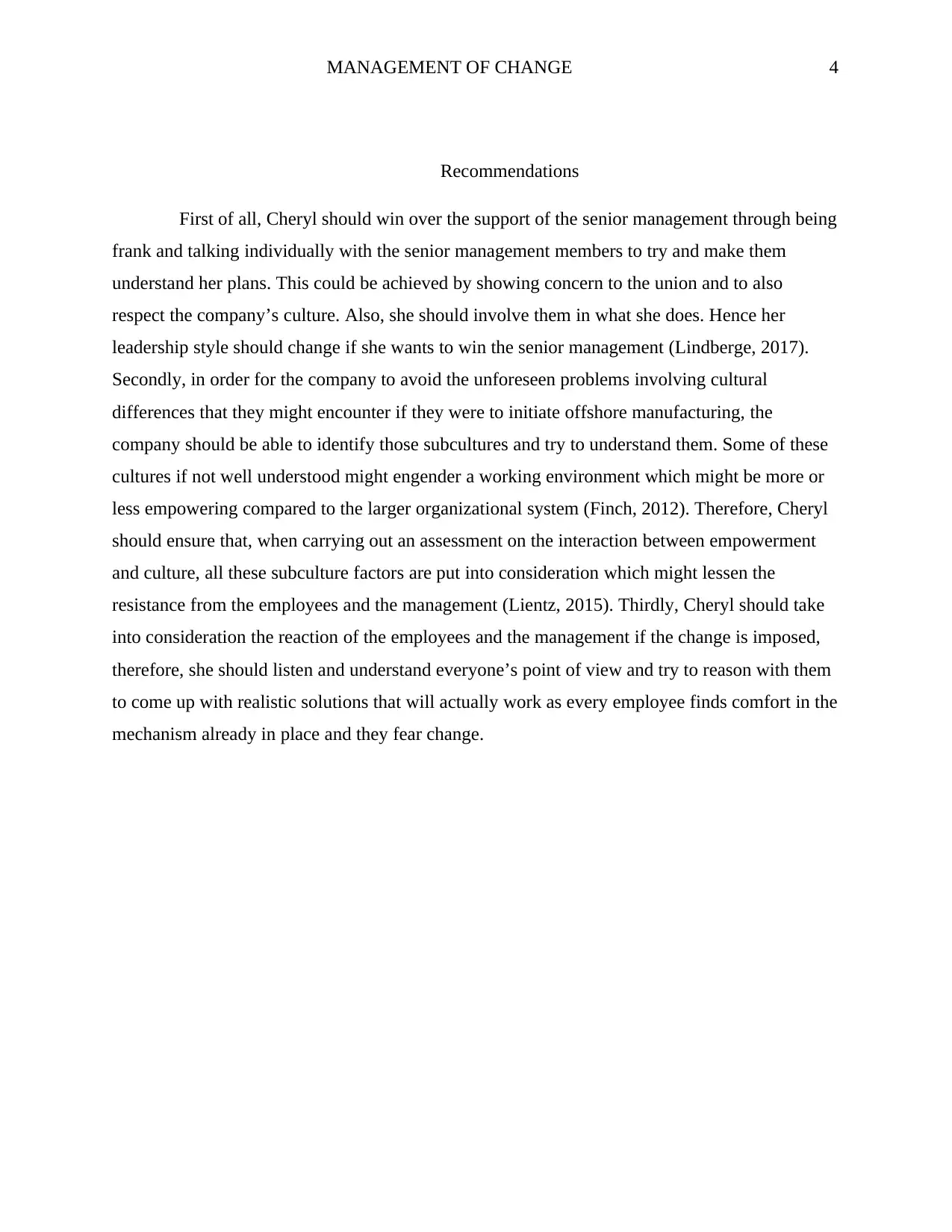
MANAGEMENT OF CHANGE 4
Recommendations
First of all, Cheryl should win over the support of the senior management through being
frank and talking individually with the senior management members to try and make them
understand her plans. This could be achieved by showing concern to the union and to also
respect the company’s culture. Also, she should involve them in what she does. Hence her
leadership style should change if she wants to win the senior management (Lindberge, 2017).
Secondly, in order for the company to avoid the unforeseen problems involving cultural
differences that they might encounter if they were to initiate offshore manufacturing, the
company should be able to identify those subcultures and try to understand them. Some of these
cultures if not well understood might engender a working environment which might be more or
less empowering compared to the larger organizational system (Finch, 2012). Therefore, Cheryl
should ensure that, when carrying out an assessment on the interaction between empowerment
and culture, all these subculture factors are put into consideration which might lessen the
resistance from the employees and the management (Lientz, 2015). Thirdly, Cheryl should take
into consideration the reaction of the employees and the management if the change is imposed,
therefore, she should listen and understand everyone’s point of view and try to reason with them
to come up with realistic solutions that will actually work as every employee finds comfort in the
mechanism already in place and they fear change.
Recommendations
First of all, Cheryl should win over the support of the senior management through being
frank and talking individually with the senior management members to try and make them
understand her plans. This could be achieved by showing concern to the union and to also
respect the company’s culture. Also, she should involve them in what she does. Hence her
leadership style should change if she wants to win the senior management (Lindberge, 2017).
Secondly, in order for the company to avoid the unforeseen problems involving cultural
differences that they might encounter if they were to initiate offshore manufacturing, the
company should be able to identify those subcultures and try to understand them. Some of these
cultures if not well understood might engender a working environment which might be more or
less empowering compared to the larger organizational system (Finch, 2012). Therefore, Cheryl
should ensure that, when carrying out an assessment on the interaction between empowerment
and culture, all these subculture factors are put into consideration which might lessen the
resistance from the employees and the management (Lientz, 2015). Thirdly, Cheryl should take
into consideration the reaction of the employees and the management if the change is imposed,
therefore, she should listen and understand everyone’s point of view and try to reason with them
to come up with realistic solutions that will actually work as every employee finds comfort in the
mechanism already in place and they fear change.
Paraphrase This Document
Need a fresh take? Get an instant paraphrase of this document with our AI Paraphraser
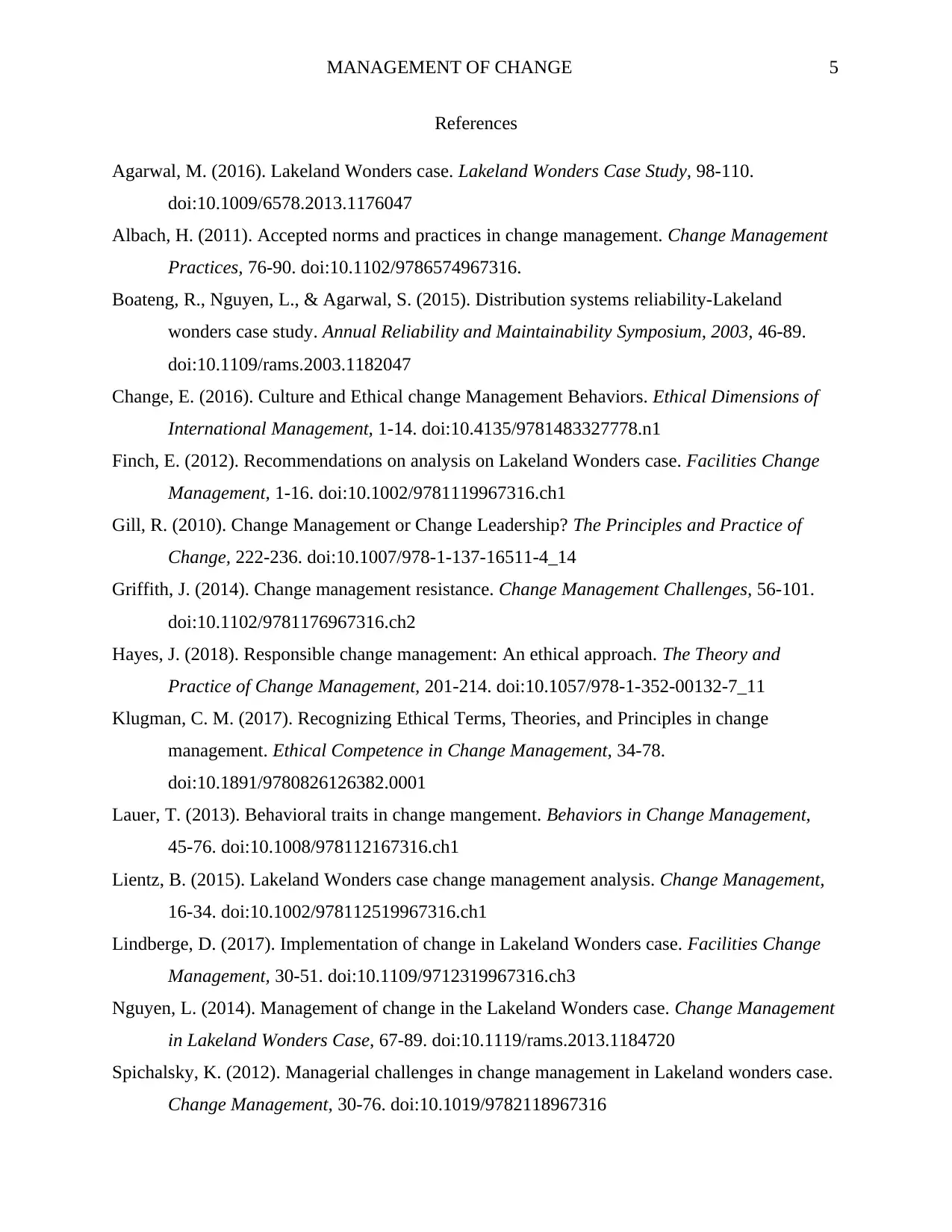
MANAGEMENT OF CHANGE 5
References
Agarwal, M. (2016). Lakeland Wonders case. Lakeland Wonders Case Study, 98-110.
doi:10.1009/6578.2013.1176047
Albach, H. (2011). Accepted norms and practices in change management. Change Management
Practices, 76-90. doi:10.1102/9786574967316.
Boateng, R., Nguyen, L., & Agarwal, S. (2015). Distribution systems reliability-Lakeland
wonders case study. Annual Reliability and Maintainability Symposium, 2003, 46-89.
doi:10.1109/rams.2003.1182047
Change, E. (2016). Culture and Ethical change Management Behaviors. Ethical Dimensions of
International Management, 1-14. doi:10.4135/9781483327778.n1
Finch, E. (2012). Recommendations on analysis on Lakeland Wonders case. Facilities Change
Management, 1-16. doi:10.1002/9781119967316.ch1
Gill, R. (2010). Change Management or Change Leadership? The Principles and Practice of
Change, 222-236. doi:10.1007/978-1-137-16511-4_14
Griffith, J. (2014). Change management resistance. Change Management Challenges, 56-101.
doi:10.1102/9781176967316.ch2
Hayes, J. (2018). Responsible change management: An ethical approach. The Theory and
Practice of Change Management, 201-214. doi:10.1057/978-1-352-00132-7_11
Klugman, C. M. (2017). Recognizing Ethical Terms, Theories, and Principles in change
management. Ethical Competence in Change Management, 34-78.
doi:10.1891/9780826126382.0001
Lauer, T. (2013). Behavioral traits in change mangement. Behaviors in Change Management,
45-76. doi:10.1008/978112167316.ch1
Lientz, B. (2015). Lakeland Wonders case change management analysis. Change Management,
16-34. doi:10.1002/978112519967316.ch1
Lindberge, D. (2017). Implementation of change in Lakeland Wonders case. Facilities Change
Management, 30-51. doi:10.1109/9712319967316.ch3
Nguyen, L. (2014). Management of change in the Lakeland Wonders case. Change Management
in Lakeland Wonders Case, 67-89. doi:10.1119/rams.2013.1184720
Spichalsky, K. (2012). Managerial challenges in change management in Lakeland wonders case.
Change Management, 30-76. doi:10.1019/9782118967316
References
Agarwal, M. (2016). Lakeland Wonders case. Lakeland Wonders Case Study, 98-110.
doi:10.1009/6578.2013.1176047
Albach, H. (2011). Accepted norms and practices in change management. Change Management
Practices, 76-90. doi:10.1102/9786574967316.
Boateng, R., Nguyen, L., & Agarwal, S. (2015). Distribution systems reliability-Lakeland
wonders case study. Annual Reliability and Maintainability Symposium, 2003, 46-89.
doi:10.1109/rams.2003.1182047
Change, E. (2016). Culture and Ethical change Management Behaviors. Ethical Dimensions of
International Management, 1-14. doi:10.4135/9781483327778.n1
Finch, E. (2012). Recommendations on analysis on Lakeland Wonders case. Facilities Change
Management, 1-16. doi:10.1002/9781119967316.ch1
Gill, R. (2010). Change Management or Change Leadership? The Principles and Practice of
Change, 222-236. doi:10.1007/978-1-137-16511-4_14
Griffith, J. (2014). Change management resistance. Change Management Challenges, 56-101.
doi:10.1102/9781176967316.ch2
Hayes, J. (2018). Responsible change management: An ethical approach. The Theory and
Practice of Change Management, 201-214. doi:10.1057/978-1-352-00132-7_11
Klugman, C. M. (2017). Recognizing Ethical Terms, Theories, and Principles in change
management. Ethical Competence in Change Management, 34-78.
doi:10.1891/9780826126382.0001
Lauer, T. (2013). Behavioral traits in change mangement. Behaviors in Change Management,
45-76. doi:10.1008/978112167316.ch1
Lientz, B. (2015). Lakeland Wonders case change management analysis. Change Management,
16-34. doi:10.1002/978112519967316.ch1
Lindberge, D. (2017). Implementation of change in Lakeland Wonders case. Facilities Change
Management, 30-51. doi:10.1109/9712319967316.ch3
Nguyen, L. (2014). Management of change in the Lakeland Wonders case. Change Management
in Lakeland Wonders Case, 67-89. doi:10.1119/rams.2013.1184720
Spichalsky, K. (2012). Managerial challenges in change management in Lakeland wonders case.
Change Management, 30-76. doi:10.1019/9782118967316
1 out of 5
Related Documents
Your All-in-One AI-Powered Toolkit for Academic Success.
+13062052269
info@desklib.com
Available 24*7 on WhatsApp / Email
![[object Object]](/_next/static/media/star-bottom.7253800d.svg)
Unlock your academic potential
Copyright © 2020–2025 A2Z Services. All Rights Reserved. Developed and managed by ZUCOL.





